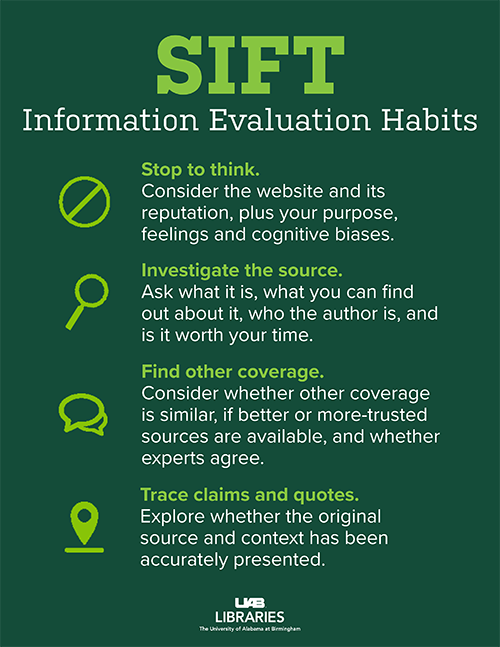
“The ability to make decisions, communicate and govern effectively is on the line without access to political communication. We need to be able to understand what information is meant to inform, to influence, and to interfere.” —Brooke Becker, media literacy librarian for UAB Libraries
Social media posts, viral videos, emails, news articles — the incoming tide of seemingly limitless information can seem overwhelming at any time, but especially during an election season, says Brooke Becker, media literacy librarian for UAB Libraries.
“To find stable footing in that flood, it’s important to cultivate skills to determine if what you’re consuming is accurate,” she explained.
The intent of political advertising is to rally votes, generate enthusiasm for a candidate or issue, define (or redefine) a candidate’s image, and provide general information. Each of these enables constituents to make informed decisions — a crucial aspect of democracy, Becker says.
“The ability to make decisions, communicate and govern effectively is on the line without access to political communication,” Becker said. “We need to be able to understand what information is meant to inform, to influence, and to interfere.”
Consuming inaccurate information can negatively impact one’s ability to make important decisions around issues such as health, finances, business, and education — in all aspects of life, Becker explains, not just during an election season. Understanding how to determine a reliable source from an unreliable one enables consumers to make informed decisions.
Becker stresses that one of the key factors to remember in the era of social media and email is that “clear and effective communication isn’t just about exchanging information quickly.” The most important factor is the quality of a piece of information.
“Great communication requires making valid points while providing accurate examples that others can easily follow and understand,” she said.
Positivity, negativity and neutrality
|
“Great communication requires making valid points while providing accurate examples that others can easily follow and understand.” |
Understanding the basic intent behind a political advertisement is crucial, Booker explains. A key component is understanding whether an ad is positive (presenting the candidate, campaign or policy in the best light), negative (emphasizing deficiencies), or neutral (presented without clear bias for or against). Here are a few questions she recommends asking when viewing an ad:
- What is the ad about?
- Is it positive, negative or neutral?
- What do you learn from it?
- Who do you think created it?
- Who do you think is the target audience?
Remember regulatory rules
The regulations on political advertisements also are necessary to keep in mind, Becker says. According to the American Bar Association, lying in political advertisements is legal — political ads are considered political speech, which is protected by the First Amendment: “The rationale behind this is that voters have a right to uncensored information from candidates, which they can then evaluate themselves before making their decisions at the ballot box,” according to the ABA website.
There are some caveats: Certain advertisements in newspapers and broadcast media require disclaimers, per the Federal Election Commission. Search engines have their own sets of specific policies (see Google’s online), and social media is governed by the terms of each platform’s specific usage agreements.
“Being familiar with the regulations around political ads and the channels you see them on is crucial to being able to separate fact from fiction,” Becker said.
 The CRAAP Test
The CRAAP Test
The humorously named CRAAP Test is an easy and unique way to evaluate the media one consumes, Becker says: Be sure to note an advertisement’s Currency, Relevance, Authority, Accuracy, and Purpose of Sources.
- Currency: Is the source up to date? Time-sensitive topics need current information; pay attention to words like “today” or “Tuesday” and be sure to connect them to a specific date.
- Relevance: Sources should address the intended audience’s needs.
- Authority: Consider whether the author or publisher is considered trustworthy in their field and evaluate credibility by validating their expertise or reputation in a specific industry.
- Accuracy: Check that the information is supported by evidence and cited correctly; look for documented sources with specific facts and precise details.
- Purpose: Ask the question, “Why does this information exist?” Consider the motive behind publishing; the most reliable sources explain or pass along information, rather than work to persuade or sway.
Bonus tip: Remember the SIFT Method
Using the SIFT Method is another way to ensure you can differentiate between the good, the bad and the ugly when evaluating media sources, Becker explains. Developed by Mike Caufield at Washington State University, Vancouver, the method encourages consumers to Stop, Investigate, Find and Trace information when reviewing for mis- or disinformation.
